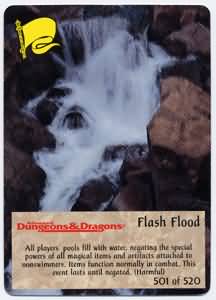
| Natural Hazards in the Wilderness | WSG |
A flood is the result
of the two most basic properties of water (or
any other liquid):
It flows from a place of higher elevation to a
place of lower elevation,
and it spreads out to cover the bottom
and sides of whatever
it is contained in. When a volume of water
is too large to
be held within a container, the overflow does just
that - it flows
over and upon the AREA adjacent to the container.
A flood can occur
after a period of heavy rain in a low-lying area
or an AREA that
is lower in elevation than the land around it. In temperate
or colder climates
during late winter and early spring, a
flood can also result
when the temperature is unusually high for
several days in
a row. The heat wave causes the snow cover to
melt rapidly, producing
water at a rate faster than the groundís
ability to absorb
it. Floods of this sort can produce enormous
amounts of overflowing
water, as the accumulated solid precipitation
of the winter months
is abruptly converted to liquid -- and
the flood is intensified
if the ground under the snow cover is frozen
or partially frozen,
since this further reduces its ability to soak
up the water.
Usually, flooding
will only occur in an AREA adjacent to a river or
a lake that is fed
by rivers. The excess rainfall || melted snow
flows from higher
elevation to lower elevation, eventually finding
its way into a river
or lake (which is as low as it can go). But that
container isnít
large enough to hold the extra volume, so the water
ends up spilling
out over the river bank or lake shore and inundating
an area of land
that is not normally underwater.
A flash flood occurs
for the same reasons that a regular flood
does, but its nature
and its effects are quite different. A flash flood
is a fleeting (and
fleet) phenomenon; a mass of water in a flash
flood may pass through
an area in minutes, in contrast to a regular
flood that builds
slowly and usually inundates an area for several
days before beginning
to recede.
Flash floods occur
most often in mountainous or hilly
terrain after
a heavy rain, in
locations where a natural body of water (a river
or a lake) is not
present. The rainfall runs down slopes and accumulates
in low spots, then
continues to seek even lower elevation.
As the water moves
lower and lower on its journey down a
mountain or hillside,
it increases volume and picks up speed. A
flash flood that
began as a trickle at an elevation of 10,000 feet
can be a rushing
torrent by the time it descends to 5,000 feet -
thousands of gallons
of water moving forward and down at a
speed of 30 to 50
miles per hour. When a tidal wave (see the preceding
section) rushes
inland, it produces effects very similar to
those of a flash
flood.
The only way to avoid
a flood is to move away from the affected
AREA before it becomes
inundated. Itís not difficult to avoid a normal
flood, since the
water level in the flooded area doesnít increase
abruptly. But itís
a bad idea to travel through or make
camp in a mountain
pass or a gully if a storm is brewing or if it has
rained within the
last two or three hours; a flash flood can come
rushing through
such an area with very little warning to characters
or creatures in
its path.
Common sense and
circumstances will dictate what happens
to a character caught
in a flash flood. If he has proficiency in
swimming, he can
probably avoid drowning, but he may still suffer
damage from being
slammed against rocks, trees, etc., by the
onrushing water.
A character without proficiency in swimming
can survive by treading
water or holding his breath, but will need
to find a place
of refuge before he tires. If the path of the water
carries a character
past outcroppings and other protrusions, he
may be able to grab
something and hold on until the flood moves
past that location.
If such protrusions are available, a successful
Strength Check indicates
that the character has managed to
latch on to something.
Failure on this check indicates that the
character has been
battered against the protrusion he was trying
to grab, and he
will suffer ld3 to ld6 points of damage (depending
on thevelocityof
the water and the nature of the protrusion). If
this initial Strength
Check succeeds, the character must make
another Strength
Check every two rounds for as long as the water
continues to rush
past; failure indicates that the force of the water
has pulled his grasp
loose, and he will again be carried downstream
until the velocity
of the flood abates or until he is able to
grab another protrusion.
With reference to any particular point
along its path,
a flash flood will last for 10-15 rounds (d6 +9). After
the flood passes,
any level area it has moved through will still be
covered to some
depth by gently flowing water for the next 3d8
hours.